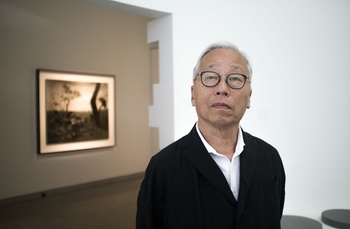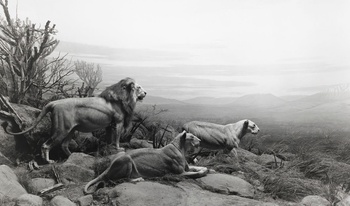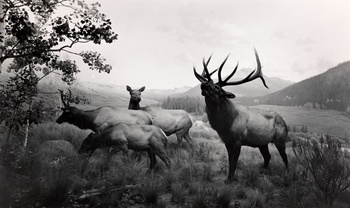In the exhibition “Still Life”, world-renowned photographer Hiroshi Sugimoto demonstrates yet again that he is a master of time.
Gemsbok, 1980
What happens if you shoot a whole movie into a single frame?” This is the question that Hiroshi Sugimoto asked himself as a 28-year-old in 1976. Originally from Japan, he had just moved to New York after studying design at an arts academy in California. Sugimoto, who was born in Tokyo in 1948, smuggled a large format camera into St. Marks Cinema in the East Village. The resulting image provided him with the answer that he had hoped for. The passing of time transforms into a gleaming white screen that lights up the entire theatre. The series made him world famous.

© Heleen Rodiers
In the exhibition “Still Life”, Sugimoto is juxtaposing his own work with that of the Flemish Primitives for the first time. “This was a very challenging project. We are competing with each other. I don’t want to lose, but I can never win,” Sugimoto smiles. We sit in the exhibition space surrounded by his black and white images, printed on a large scale. The greying photographer answers my questions calmly and collectedly, while his eye occasionally drifts to his assistants who are putting the finishing touches to the exhibition.
Oh, I do get many requests to photograph real people, but I always respond: ‘Please die first, be waxed, and then come back.
It is not the movie theatres but three other series that enter into dialogue with a number of paintings in the permanent collection of the Royal Museums. One of the most impressive series is the ongoing Diorama series, which he started in the mid-1970s, around the same time as the theatre series. He photographed scenes with the taxidermized animals at the American Museum of Natural History. Sugimoto is a master of long-exposure photography and large format cameras. The black and white gelatin silver prints are rich in detail, beautifully lit, static but not deadened. Sugimoto: “Photography used to be believable. That was the nature of photography. Not so anymore in the digital world where we can turn everything into a fantasy. But when I started with the diorama series people still believed in the objectivity of photography. I transformed the reality of these fake scenes into the photo reality. Nothing is real but on the other hand nothing is fake, the result is somewhere in between. It is a space I create with my own imagination. It’s an interesting thought. Turning stuffed animals and a painted background into something real. It’s a great study on how the human mind works.”

Hiroshi Sugimoto Lion, 1994 - Private Collection
The combination of masterpieces from the permanent collection with Sugimoto’s photos works incredibly well but it is not surprising. “I’ve always been interested in the history of art and Flemish painting in particular. The way that the stuffed animals in my dioramas are arranged against the painted background related to the conventions of painting. I found many similarities, especially in Deer Hunting by Paul De Vos and Jan Wildens.”

Hiroshi Sugimoto Henry VIII, 1999 - Private Collection
Time Machine
Sugimoto’s Portraits series is propelled by the same real or fake premise. Even though we know that the portrait of Napoleon cannot be real – he died before the invention of photography – the portrait of his wax statue at Madame Tussaud’s still confuses us. Historical figures like Henry VIII or Catherine Howard are carefully exposed and photographed against a solid black background. This series refers directly to the history and conventions of painting. The wax figures were based on portraits by painters like David, Holbein, or Vermeer. Does he ever photograph real people? Sugimoto: “Oh, I do get many requests, but I always respond: ‘Please die first, be waxed, and then come back.’” [Laughs very loud] “No, it’s because real people move. My portraits take a twenty- or thirty-minute exposure. It’s more of a technical issue. I need the long exposures for the extreme sharpness and detail.”

Hiroshi Sugimoto, Wapiti, 1980 - Private Collection
Time is also captured in Photogenic Drawing, the last series in the exhibition. Sugimoto managed to get hold of a number of negatives by the British photography pioneer William Henry Fox Talbot and turned them into positives. Over time, the negatives that were stabilized with a strong salt solution begin to fade until they disappear completely. These positives breathe new life into Talbot’s very old work. Sugimoto: “Photography is a time machine, in a way, to preserve memory, to preserve time.”
> Hiroshi Sugimoto: Still Life. > 19/8, Royal Museums of Fine Arts of Belgium
Read more about: Expo
Fijn dat je wil reageren. Wie reageert, gaat akkoord met onze huisregels. Hoe reageren via Disqus? Een woordje uitleg.